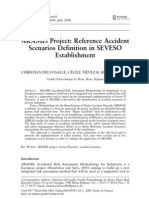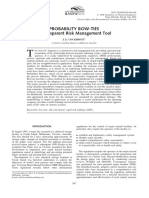Bow Tie Basic
Bow Tie Basic
Uploaded by
Anonymous WsaaJcd6Copyright:
Available Formats
Bow Tie Basic
Bow Tie Basic
Uploaded by
Anonymous WsaaJcd6Original Description:
Copyright
Available Formats
Share this document
Did you find this document useful?
Is this content inappropriate?
Copyright:
Available Formats
Bow Tie Basic
Bow Tie Basic
Uploaded by
Anonymous WsaaJcd6Copyright:
Available Formats
THE INCREASING BENEFITS OF BOW-TIE DIAGRAMS
IN THE RISK MANAGEMENT PROCESS
James Phipps, Prem P. Sharma
ABS Consulting Inc.
1. INTRODUCTION
Hydrocarbon releases are an inherent hazard associated with the petro-chemicals and associated
industries. Preventing, or minimising the potential for, such releases occurring, is foremost among any
companys safety culture and the effective implementation of a Health, Safety and Environmental
Management System (HSE-MS) is one of the means by which this is achieved.
In many regions of the world, legislation has forced the implementation of such processes. The
notable driving force behind the derivation of the Bow-Tie diagram as a representation of the
Management System stems from the Lord Cullen enquiry into the tragic events of Piper Alpha in the
UK North Sea in 1988, in which some 167 offshore workers lost their lives. Similar events around the
world have triggered further emphasis on the HSE-MS such as Seveso. More recently, with the release
of the Baker Panel report into the BP Texas City disaster an additional drive into such a culture is
expected.
Rather than simply adopt national regulation as a means of suitable compliance, larger
corporations are implementing global standards by which operating divisions are expect to perform in
addition to that which may be required by law.
The purpose of this paper is to overview how a Bow-Tie tool, could be developed and applied
not only to demonstrate the implementation of an HSE Management System but also fostering a culture
of risk management that has become a essential tool in managing business in todays world . The paper
also highlights the benefits and advantages of applying THESIS as opposed to traditional paper-based
approaches.
2. HSE MANAGEMENT SYSTEMS
A HSE Management System is a quality managed system for managing risks within a company,
to assure the protection of the companys people, assets, reputation and for protection of the
environment the company operates within.
In general, HSE Management Systems follow the same basic structure. The following
hypothetical HSE Management System, comprising the main elements shown, is representative of
such a structure (Figure 1).
Leadership and Commitment
Policy and Strategic Objectives
Organisation, Responsibilities
Resources, Standards and Doc.
Hazards and Effects
Management
Corrective Action
Planning and Procedures
Implementation
Monitoring
Audit
Corrective Action
and Improvement
Management Review
Corrective Action
and Improvement
Figure 1 Indicative HSE Management System Hierarchy
AmCham HSSE Conference & Exhibition Trinidad & Tobago
Associated with each of the above elements are specific requirements. These requirements can
be generally categorised as sown in Figure 2.
THESIS can be used to demonstrate how the pertinent HSE Management System element
requirements are met with respect to the control and management of hazards and risks.
Leadership & Commitments
ELEMENTS
REQUIREMENTS
HSE Policy
Strategic Objectives & Targets
Policy & Strategic Objectives
Organisation, Responsibilities,
Resources, Stands & Docs.
Hazard & Effects Management Process
Planning & Procedures
Implementation & Monitoring
Audit
Organisational Structure & Responsibilities
Management Representatives
Resources
Competence
Contractors
Communication
Documentation & its Control
Identification of Hazards & Effects
Risk Evaluation
Recording of Hazards & Effects
Objectives of Performance Criteria
Risk reduction Measures
Asset Integrity
Procedures & Work Instructions
Management of Change
Contingency & Emergency Planning
Monitoring
Records
Non-Compliance & Corrective Action
Incident Reporting & Follow-Up
Review
Internal Audit
Independent Audits
Management Review
Figure 2 Indicative Functional Requirements
3. INTRODUCTION TO BOW-TIES
3.1.
Bow-Ties
Bow-Ties are a graphical display of the relationship between the various components that result
from the Hazard and Effects Management Process (HEMP, see HSE Management System element
above). They depict the relationship between Hazards, Threats, Barriers, Escalation Factors, Controls,
Consequences, Recovery Preparedness Measures and Critical Tasks, as illustrated in Figure 3, below.
The advantage of adopting the Bow-Tie approach is that it is an extremely powerful
representation of a hazard analysis and HEMP Process and are readily understood at all levels in an
organisation.
It is through the linking of Critical Tasks to Barriers, Escalation Factor Controls and Recovery
Preparedness Measures that Bow Ties can demonstrate the implementation of a HSE Management
System in managing the risk associated with hazards, in particular, hydrocarbon release scenarios.
3.2.
Critical Tasks
Each Barrier, Control and Recovery Preparedness Measure should have, as a minimum, one
supporting task, to ensure that the integrity of each barrier, control and recovery preparedness measure
is maintained. These are termed Critical Tasks, and are required to be performed, undertaken or
executed by responsible and competent persons.
AmCham HSSE Conference & Exhibition Trinidad & Tobago
Escalation
factors
Escalation
factors
Control of
escalation
factor
Control of
escalation
factor
Consequences
Barriers to
prevent
threat
Recovery
preparedness
measures
Hazard
Threat
that could
release
hazard
Top event
Consequences
Consequences
Activities & tasks
= HSE-critical task
Figure 3 Schematic Bow Tie Diagram
The tasks may be design, inspection and maintenance, operational or administrative tasks, i.e.:
Design Tasks - which specify the necessary hardware and equipment;
Inspection and Maintenance Tasks - to ensure that this hardware and equipment
maintains its integrity and reliability;
Operational Tasks - to ensure that the equipment is used within the defined limits of
the controls provided; and
Administrative Tasks - which provide the necessary training, awareness and
behaviour conditioning to ensure that people perform predictably in all normal and
abnormal situations.
It can be seen from the above categorisation that the tasks are directly linked to the HSE
Management System elements and their requirements, i.e. it is through the linking of Critical Tasks to
Barriers, etc., that Bow Ties can demonstrate the implementation of a HSE-MS in managing the risk
associated with a hazard, for example a hydrocarbon release scenario.
Critical Tasks can also be used to audit a companys HSE Management System, as depicted in
Figure 4.
H
A
Z
A
R
D
AUDIT CHECKLIST
C
O
N
S
E
Q
U
E
N
C
E
S
THREAT
MAJOR
LOSS
Project Manager
Task 1 .
Task 3 .
Ops. Manager
Check
accuracy
Task 5 .
Task 9 .
Task 11 ...
RISK MANAGEMENT TASKS LIST
Responsible
Person:
Project Manager
Task 1: ..
Task 2: ..
Task 3: ..
Verify
performance
Figure 4 Audits, Bow-Ties & HSE-Critical Tasks
AmCham HSSE Conference & Exhibition Trinidad & Tobago
Once the Critical Tasks are defined, personnel are assigned the responsibility for the execution
of the tasks. Such persons are identified from the organisation at the time of undertaking the work and
should remain, at the least, at a supervisory level. Where possible, one person per task should be
assigned.
3.3.
Illustrative Example of the Linkage Between Bow-Ties, Barriers, Critical Tasks and
HSE Management Systems
To demonstrate the relationship between Bow-ties, Barriers, Critical Tasks and HSE
Management Systems, consider the following example, which is an extract from a study conducted on
offshore asset in the Caribbean.
Figures 5 and 6 show the typical arrangement of the Left (Threat) and Right (Consequence) side
of a Bow Tie diagram, created using the THESIS code.
3.3.1.
Left Side of Bow Tie Threat Barriers
Illustrative (Figures 5) is an example showing Critical Tasks to ensure that the integrity of the
barriers to threat of internal corrosion to pipeline integrity is maintained:
Threat Internal Corrosion & Erosion
o Barrier 1 NDT Inspection (In-Line Inspection/Intelligent Pigging)
Critical Task 1 Periodic In line inspection (ILI) for integrity
assessment of pipeline,
Escalating Factor (a) Inspector/Evaluator Competence,
Lack of ILI Inspection Plan,
o Critical Task (a1) Performance standards &
qualification
o Critical Task (b2) Documenting, approval and
implementation of ILI tool performance standard
o Barrier 2 Well Sampling
Critical Task 2 Monitoring corrosive contents of produced oil &
gas,
Escalating Factor (a) Sampling process not followed
o Critical Task (a1) Operator Training
o Critical Task (b2) Standard Operating Procedures
Fatigue&vibration
Threat
Internal Corrosion &
erosion
Threat
NDT inspection
Well sampling
<None>
<None>
H1-03 Mechanical energy
Inspector competence
Escalation Factor
Performance standards
Approved contractors
<None>
<None>
Loc.:
TE:
Sampling process not
adhered to
Escalation Factor
Teak A Platform
Failure of
equipment
Operator training
Operator monitoring
Company procedures & reports
<None>
<None>
<None>
External Corrosion
Threat
Overload
Threat
Human error
Threat
Figure 5 Threat Barriers & Critical Tasks (Left Side of Bow Tie)
AmCham HSSE Conference & Exhibition Trinidad & Tobago
Other more generic examples for threat (probability of failure) related critical tasks would be:
Pressure Relief Valve (PRV): Ensure that routine/specific maintenance, inspection
and testing activities undertaken on PRVs are planned, managed and conducted in
accordance with the maintenance frequencies, procedures, guidelines, checklists and
techniques specified in the appropriate documentation to ensure that they are
maintained in a safe and fit-for-purpose condition.
System Strength Tested: Ensure that system is pressure tested in accordance with the
requirements specified in Safe Operating Procedure: Pressure Testing of Equipment.
Illustrative Figure 6 is an example showing Critical Tasks to ensure that the integrity of the
barriers to consequence of equipment failure is maintained. Critical Tasks for pipeline failure would
include:
Consequence Environmental impact due to spill
o Barrier 1 Emergency response plan for spills
Critical Task 1 Execute emergency spill response for containment
and remediation.
Escalating Factor (a) Containment equipment inadequate
or not operating
o Critical Task (a1) QRA/Spill analysis studies
o Critical Task (b2) Equipment Maintenance
Program
Guards and shielding installed
Compressor enclosures
EMTs and first aid area
<None>
<None>
<None>
Injury or fatality (flying
objects, trapped)
Consequence
C3
Inspection and
maintenance not
undertaken per schedule
Escalation Factor
Offshore planning meetings &
supervision
<None>
Inspector competence
H1-03 Mechanical energy
Loc.:
TE:
Teak A Platform
Failure of
equipment
Performance standards
<None>
<None>
Escalation Factor
Loss of power from
generators
+
B4
Stand-by generator
Approved contractors
Consequence
B4
B4
B4
<None>
Production Loss
Consequence
Redundancy in equipment
<None>
Fire and/or explosion
B4
Consequence
B4
B4
B4
Environmental impact
Emergency response plans for oil spill
Mutual assistance agreement with
other parties
Spill clean-up kits
Stand-by boat for clean up
<None>
<None>
<None>
<None>
Consequence
D3
D1
B3
Figure 6 Consequence Barriers & Critical Tasks (Right Side of Bow Tie)
Other more generic examples for consequence related critical tasks would be:
Gas Leak Detection & Alarm: Ensure that routine/specific maintenance, inspection
and testing activities undertaken on Gas Detectors are planned, managed and conducted
in accordance with the maintenance frequencies, procedures, guidelines, checklists and
techniques specified in the appropriate documentation to ensure that they are
maintained in a safe and fit-for-purpose condition.
AmCham HSSE Conference & Exhibition Trinidad & Tobago
Ignition Source Control: Ensure that hazardous area classification and zoning, and
corresponding drawings, are completed prior to construction/modification of
plant/equipment in accordance with procedures and/or requirements. Ensure that
permanent electrical equipment in hazardous zones are appropriately rated. Verify
hazardous area classification drawings against actual design.
As can be seen from the above examples, Critical Tasks are developed from the HSE
Management System as well as other sources.
4. BENEFITS & ADVANTAGES OF USING BOW TIES
There are many benefits and advantages to using and applying Bow Ties, some of which have
already been described above. In summary, subject to the nature of the particular application, they can
be used for/to:
Documents the analysis in a systematic manner and in a way that makes the control of
hazards easier for personnel to understand.
Linking of hazards, controls, etc. to Critical Activities and Tasks via Bow-Ties.
Therefore, it
ensures that controls identified from a risk assessment are linked to the companys
processes and to individuals responsibilities
.Provides reports which can form part of a Formal Safety Assessment, e.g. HSE Case,
or which can be used for communication to those personnel responsible for safetycritical tasks.
Provides an essential source of risk management information a corporate memory
to prevent losses occurring or re-occurring.
Documents all areas where shortfalls have been identified and corrective action is
required, and assigns responsibilities for completion of the actions
Supports audits of HSE Management Systems.
Facilitates a continuous improvement process for risk management.
Promotes visibility and awareness of hazards, risks and HSE Management.
Used for hazard awareness training
Incident investigation
Preparation of emergency exercises
Audit checklists/planning:
e.g. Critical Tasks can be used as the basis for audit checklists
Input into operating procedures, job descriptions, annual tasks and targets, defining
individual roles & responsibilities, etc.
You might also like
- Example 2 CANADIAN SOLAR Case Analysis 1Document8 pagesExample 2 CANADIAN SOLAR Case Analysis 1dasniel3No ratings yet
- Bowtie Analysis of Macondo BlowoutDocument12 pagesBowtie Analysis of Macondo BlowoutElliot Yibaebi100% (2)
- Bow-Tie - An Elegant SolutionDocument3 pagesBow-Tie - An Elegant SolutionRoberto BurgosNo ratings yet
- Process Safety Performance IndicatorsDocument30 pagesProcess Safety Performance Indicatorskanakarao1100% (2)
- Guidelines for Auditing Process Safety Management SystemsFrom EverandGuidelines for Auditing Process Safety Management SystemsNo ratings yet
- Essential Practices for Creating, Strengthening, and Sustaining Process Safety CultureFrom EverandEssential Practices for Creating, Strengthening, and Sustaining Process Safety CultureNo ratings yet
- Guidelines for Defining Process Safety Competency RequirementsFrom EverandGuidelines for Defining Process Safety Competency RequirementsRating: 3 out of 5 stars3/5 (1)
- Bow Tie TechniqueDocument26 pagesBow Tie Techniquebaaziz2015100% (1)
- Bow Tie Analysis - Incident-InvestigationDocument46 pagesBow Tie Analysis - Incident-InvestigationVikas Nigam100% (3)
- Bowtie Course - Bowtie Barrier-Based Risk ManagementDocument4 pagesBowtie Course - Bowtie Barrier-Based Risk ManagementglenlcyNo ratings yet
- BOw TIeDocument10 pagesBOw TIeDave C100% (2)
- Tripod Beta - Sledge Hammer - Final Final-2Document1 pageTripod Beta - Sledge Hammer - Final Final-2satrio aryo100% (1)
- Bow-Tie Analysis & HSECES: Course Information SheetDocument3 pagesBow-Tie Analysis & HSECES: Course Information SheetSayed Saad Shehata100% (1)
- Bow Tie Ebook PDFDocument23 pagesBow Tie Ebook PDFasu100% (3)
- Bowtie MethodDocument91 pagesBowtie MethodAgung Patra Syahbana100% (1)
- Comparison of Pha Methods PDFDocument10 pagesComparison of Pha Methods PDFQayyum KhanNo ratings yet
- An Engineer S Guide To MocDocument5 pagesAn Engineer S Guide To MocAnonymous 1XHScfCI100% (2)
- Bow Tie SafetyDocument15 pagesBow Tie SafetyAshish Mishra100% (1)
- Early Identification of Process HazardsDocument85 pagesEarly Identification of Process Hazardsali zaenal abidin100% (2)
- How To Make A Bow Tie An Introduction To Process SafetyDocument55 pagesHow To Make A Bow Tie An Introduction To Process SafetyPriyo Djatmiko100% (1)
- Bow TieDocument2 pagesBow TieAnonymous ocCa18R100% (1)
- Efficient PHA of Non-Continuous Operating ModesDocument25 pagesEfficient PHA of Non-Continuous Operating ModesShakirNo ratings yet
- RSSB Investigation Guidance Part 3Document40 pagesRSSB Investigation Guidance Part 3Abdulhmeed MutalatNo ratings yet
- Implementation of A Risk-Based Process Safety Management SystemDocument22 pagesImplementation of A Risk-Based Process Safety Management SystemDeepak Dubey100% (2)
- Risktec Solutions: Bowties - One Size Fits All?Document24 pagesRisktec Solutions: Bowties - One Size Fits All?paul_bright100% (1)
- Trevor Kletz-Learning From Accidents-Gulf Professional (2001)Document156 pagesTrevor Kletz-Learning From Accidents-Gulf Professional (2001)Raju100% (3)
- Process Safety CompetencyDocument32 pagesProcess Safety CompetencyFelipe Miguel Sánchez Clements100% (4)
- TN 015 Overrides 15Document8 pagesTN 015 Overrides 15Luis SantosNo ratings yet
- Human Error Identification in Human Reliability Assessment - Part 1 - Overview of Approaches PDFDocument20 pagesHuman Error Identification in Human Reliability Assessment - Part 1 - Overview of Approaches PDFalkmind100% (1)
- Use The Bow Tie Diagram To Help Reduce Process Safety RisksDocument12 pagesUse The Bow Tie Diagram To Help Reduce Process Safety RisksVíctor LeónNo ratings yet
- Management of ChangeDocument49 pagesManagement of Changealgiorge100% (3)
- QRA Technical Guidance - Nov16Document39 pagesQRA Technical Guidance - Nov16jiaolei9848No ratings yet
- Hopkins Thinking About Process Safety IndicatorsDocument16 pagesHopkins Thinking About Process Safety Indicatorsbinapaniki6520100% (1)
- Behavioural Safety and Major Accident Hazards Magic Bullet or Shot in The DarkDocument8 pagesBehavioural Safety and Major Accident Hazards Magic Bullet or Shot in The DarkmashanghNo ratings yet
- Human Factors Assessment Model Validation StudyDocument81 pagesHuman Factors Assessment Model Validation StudyClaudinei AguiarNo ratings yet
- Process Safety CapabilitiesDocument17 pagesProcess Safety CapabilitiesJitendra Kumar100% (1)
- Manual For Active BowTieDocument40 pagesManual For Active BowTieAli Abbasov80% (5)
- Hazard Management in Contracts Guidelines: Petroleum Development Oman L.L.CDocument13 pagesHazard Management in Contracts Guidelines: Petroleum Development Oman L.L.Csatish20ntrNo ratings yet
- ARAMIS Project - Event Prediction (General)Document19 pagesARAMIS Project - Event Prediction (General)Titania AlrayshaNo ratings yet
- Bow-Tie Lessons Learned - AicheDocument20 pagesBow-Tie Lessons Learned - Aichendve@free.fr100% (2)
- Campbell Institute An Implementation Guide To Leading IndicatorsDocument24 pagesCampbell Institute An Implementation Guide To Leading Indicatorsjrcoach100% (1)
- BowTie BowTieXP Risk Management Made EasyDocument45 pagesBowTie BowTieXP Risk Management Made EasyPaul Haydock100% (9)
- The Evaluation of Safety Barriers Using The Method LopaDocument7 pagesThe Evaluation of Safety Barriers Using The Method LopaDiegoNo ratings yet
- Incident Classification and ReportingDocument56 pagesIncident Classification and ReportingMahmoud Ahmed Ali Abdelrazik100% (2)
- Bow Tie Method - Hazard PDFDocument32 pagesBow Tie Method - Hazard PDFSathva SeelanNo ratings yet
- Bow Ties and Offshore Safety StudiesDocument3 pagesBow Ties and Offshore Safety StudiesPillai Sreejith100% (7)
- YPMT OPS PR 0027 - 旁路管理程序 OverrideBypass Management ProcedureDocument21 pagesYPMT OPS PR 0027 - 旁路管理程序 OverrideBypass Management ProcedureShanying PengNo ratings yet
- Process Safety Management Standard Audit Protocol PDFDocument19 pagesProcess Safety Management Standard Audit Protocol PDFJosé Manuel García MartínNo ratings yet
- Process Safety Management System-PaperDocument11 pagesProcess Safety Management System-PaperV. Balasubramaniam100% (2)
- Accident Investigation Method. - .Document80 pagesAccident Investigation Method. - .Sunil Jaglan100% (1)
- Accident Investigation Student HandoutDocument45 pagesAccident Investigation Student Handoutfairus75% (4)
- 06 Biofuels Mechanical IntegrityDocument26 pages06 Biofuels Mechanical IntegrityEngr Ali100% (1)
- Asset Integrity ManagementDocument5 pagesAsset Integrity ManagementLuis100% (2)
- Linking Risk Analysis To Safety Management PDFDocument6 pagesLinking Risk Analysis To Safety Management PDFfredo405No ratings yet
- Process Safety & Personal Safety in Oil Well Drilling - 2017-06-01 - ISHNDocument4 pagesProcess Safety & Personal Safety in Oil Well Drilling - 2017-06-01 - ISHNPimol SuriyaprasitNo ratings yet
- Introduction To Bow-Tie Method - DubaiDocument30 pagesIntroduction To Bow-Tie Method - DubaiMarcianito Verde100% (1)
- Probability Bow-Ties A Transparent Risk Management ToolDocument10 pagesProbability Bow-Ties A Transparent Risk Management ToolRmz ExeNo ratings yet
- Ep 95 0300 - (Hemp)Document86 pagesEp 95 0300 - (Hemp)lsaishankar100% (2)
- Risk Acceptance CriteriaDocument11 pagesRisk Acceptance Criteriabaaziz2015No ratings yet
- Economics of Solar RooftopDocument18 pagesEconomics of Solar Rooftopanujpundir2006No ratings yet
- Reduction in Steam NeDocument14 pagesReduction in Steam NeArif ShafiNo ratings yet
- Crompton GreavesDocument13 pagesCrompton GreavesAbhishek KumarNo ratings yet
- c-power-ACB (L&T)Document31 pagesc-power-ACB (L&T)Navneet Singh50% (4)
- Facility / Maintenance Management at A Glance - by Rupesh SinghDocument14 pagesFacility / Maintenance Management at A Glance - by Rupesh SinghzodhhashoNo ratings yet
- Program Day 1Document2 pagesProgram Day 1EnergyCarbon IYNo ratings yet
- Geap Bid Bulletin No 5Document7 pagesGeap Bid Bulletin No 5cassieNo ratings yet
- Oxy CuttingDocument2 pagesOxy CuttingAbdul Hakam Mohamed YusofNo ratings yet
- Hydrovane ControllerDocument5 pagesHydrovane ControllerMark Carter100% (2)
- Dividend Radar 2023-02-24Document315 pagesDividend Radar 2023-02-24jenkisanNo ratings yet
- AmoniaDocument35 pagesAmonianoelia cossio0% (1)
- Thermo Trex Thermocouple Extension WireDocument2 pagesThermo Trex Thermocouple Extension WireKhin Aung ShweNo ratings yet
- TATSPL Profile PDFDocument23 pagesTATSPL Profile PDFapsinghformalNo ratings yet
- Jan - Mar 2013 - Volume-36 - Issue-1 In-House Journal of L&T ConstructionDocument56 pagesJan - Mar 2013 - Volume-36 - Issue-1 In-House Journal of L&T ConstructionpercysearchNo ratings yet
- Socioeconomic ProblemsDocument2 pagesSocioeconomic ProblemsEduardo Eribert EscobarNo ratings yet
- Civil Service Exam Practice Set 2019Document60 pagesCivil Service Exam Practice Set 2019Alaicah Ü100% (1)
- Seavitt Resume 2015 ReadDocument2 pagesSeavitt Resume 2015 ReadHumaKhursheedNo ratings yet
- LNGDocument92 pagesLNGIndra Mochtar100% (2)
- Dalian Developer - Web PDFDocument6 pagesDalian Developer - Web PDFGilbert Coffey100% (1)
- Integrys NIMEC PSADocument5 pagesIntegrys NIMEC PSAletscurecancerNo ratings yet
- Heat Integration Characteristic of Distillation SequencesDocument3 pagesHeat Integration Characteristic of Distillation Sequencesnini jasniNo ratings yet
- Research Methodolgy of IOCL Employee Satisfaction Project ReportDocument10 pagesResearch Methodolgy of IOCL Employee Satisfaction Project ReportAvilash PaulNo ratings yet
- Chambers How Regs Affect Prices v2Document47 pagesChambers How Regs Affect Prices v2ricksanchezmmcNo ratings yet
- CP Screw Compressors Below 37kW Leaflet en 6999610315Document16 pagesCP Screw Compressors Below 37kW Leaflet en 6999610315vinayakNo ratings yet
- 8.48 Sludge Thickener:: Bangalore Water Supply & Sewerage BoardDocument1 page8.48 Sludge Thickener:: Bangalore Water Supply & Sewerage Boardsharan kommiNo ratings yet
- PWC - Water Cooled Packaged UnitsDocument12 pagesPWC - Water Cooled Packaged UnitsSameera LakmalNo ratings yet
- Underground Cable Report NewDocument30 pagesUnderground Cable Report Newakash_shah111990100% (1)
- V2050 Workshop Chesham Participants List 09jun08 Excel 2003Document1 pageV2050 Workshop Chesham Participants List 09jun08 Excel 2003Ahmed Mobashshir SamaniNo ratings yet
- The RB211-535E4Document1 pageThe RB211-535E4sas100% (1)

























































































